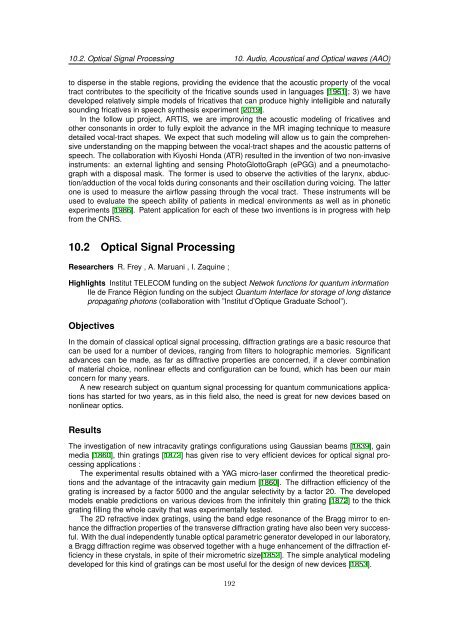TSI report for the period 2005-2009 - Département Traitement du ...
TSI report for the period 2005-2009 - Département Traitement du ...
TSI report for the period 2005-2009 - Département Traitement du ...
You also want an ePaper? Increase the reach of your titles
YUMPU automatically turns print PDFs into web optimized ePapers that Google loves.
10.2. Optical Signal Processing 10. Audio, Acoustical and Optical waves (AAO)<br />
to disperse in <strong>the</strong> stable regions, providing <strong>the</strong> evidence that <strong>the</strong> acoustic property of <strong>the</strong> vocal<br />
tract contributes to <strong>the</strong> specificity of <strong>the</strong> fricative sounds used in languages [1961]; 3) we have<br />
developed relatively simple models of fricatives that can pro<strong>du</strong>ce highly intelligible and naturally<br />
sounding fricatives in speech syn<strong>the</strong>sis experiment [2019].<br />
In <strong>the</strong> follow up project, ARTIS, we are improving <strong>the</strong> acoustic modeling of fricatives and<br />
o<strong>the</strong>r consonants in order to fully exploit <strong>the</strong> advance in <strong>the</strong> MR imaging technique to measure<br />
detailed vocal-tract shapes. We expect that such modeling will allow us to gain <strong>the</strong> comprehensive<br />
understanding on <strong>the</strong> mapping between <strong>the</strong> vocal-tract shapes and <strong>the</strong> acoustic patterns of<br />
speech. The collaboration with Kiyoshi Honda (ATR) resulted in <strong>the</strong> invention of two non-invasive<br />
instruments: an external lighting and sensing PhotoGlottoGraph (ePGG) and a pneumotachograph<br />
with a disposal mask. The <strong>for</strong>mer is used to observe <strong>the</strong> activities of <strong>the</strong> larynx, ab<strong>du</strong>ction/ad<strong>du</strong>ction<br />
of <strong>the</strong> vocal folds <strong>du</strong>ring consonants and <strong>the</strong>ir oscillation <strong>du</strong>ring voicing. The latter<br />
one is used to measure <strong>the</strong> airflow passing through <strong>the</strong> vocal tract. These instruments will be<br />
used to evaluate <strong>the</strong> speech ability of patients in medical environments as well as in phonetic<br />
experiments [1986]. Patent application <strong>for</strong> each of <strong>the</strong>se two inventions is in progress with help<br />
from <strong>the</strong> CNRS.<br />
10.2 Optical Signal Processing<br />
Researchers R. Frey , A. Maruani , I. Zaquine ;<br />
Highlights Institut TELECOM funding on <strong>the</strong> subject Netwok functions <strong>for</strong> quantum in<strong>for</strong>mation<br />
Ile de France Région funding on <strong>the</strong> subject Quantum Interface <strong>for</strong> storage of long distance<br />
propagating photons (collaboration with ”Institut d’Optique Gra<strong>du</strong>ate School”).<br />
Objectives<br />
In <strong>the</strong> domain of classical optical signal processing, diffraction gratings are a basic resource that<br />
can be used <strong>for</strong> a number of devices, ranging from filters to holographic memories. Significant<br />
advances can be made, as far as diffractive properties are concerned, if a clever combination<br />
of material choice, nonlinear effects and configuration can be found, which has been our main<br />
concern <strong>for</strong> many years.<br />
A new research subject on quantum signal processing <strong>for</strong> quantum communications applications<br />
has started <strong>for</strong> two years, as in this field also, <strong>the</strong> need is great <strong>for</strong> new devices based on<br />
nonlinear optics.<br />
Results<br />
The investigation of new intracavity gratings configurations using Gaussian beams [1839], gain<br />
media [1860], thin gratings [1872] has given rise to very efficient devices <strong>for</strong> optical signal processing<br />
applications :<br />
The experimental results obtained with a YAG micro-laser confirmed <strong>the</strong> <strong>the</strong>oretical predictions<br />
and <strong>the</strong> advantage of <strong>the</strong> intracavity gain medium [1860]. The diffraction efficiency of <strong>the</strong><br />
grating is increased by a factor 5000 and <strong>the</strong> angular selectivity by a factor 20. The developed<br />
models enable predictions on various devices from <strong>the</strong> infinitely thin grating [1872] to <strong>the</strong> thick<br />
grating filling <strong>the</strong> whole cavity that was experimentally tested.<br />
The 2D refractive index gratings, using <strong>the</strong> band edge resonance of <strong>the</strong> Bragg mirror to enhance<br />
<strong>the</strong> diffraction properties of <strong>the</strong> transverse diffraction grating have also been very successful.<br />
With <strong>the</strong> <strong>du</strong>al independently tunable optical parametric generator developed in our laboratory,<br />
a Bragg diffraction regime was observed toge<strong>the</strong>r with a huge enhancement of <strong>the</strong> diffraction efficiency<br />
in <strong>the</strong>se crystals, in spite of <strong>the</strong>ir micrometric size[1852]. The simple analytical modeling<br />
developed <strong>for</strong> this kind of gratings can be most useful <strong>for</strong> <strong>the</strong> design of new devices [1853].<br />
192


